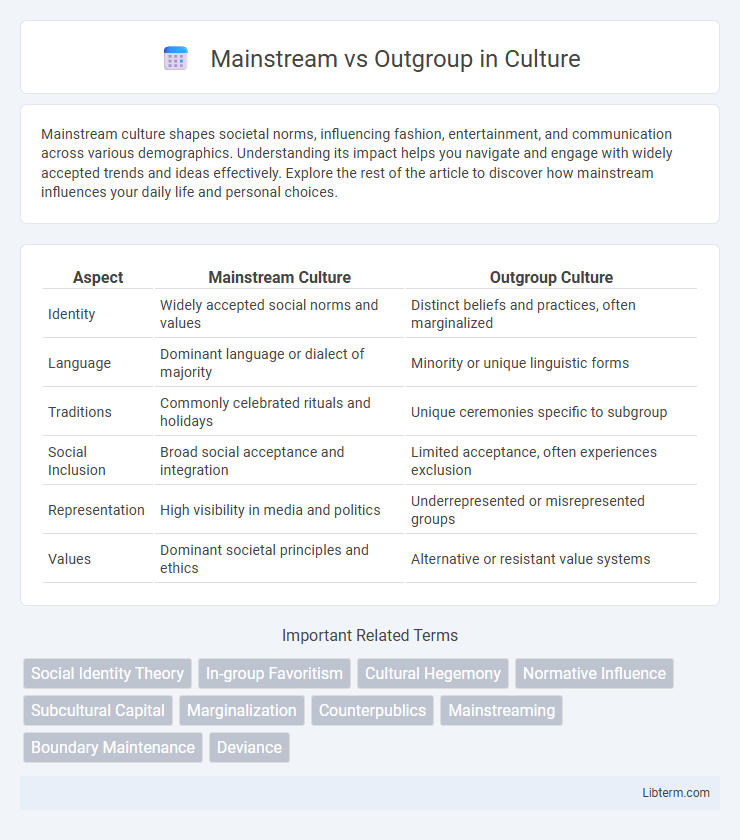Mainstream culture shapes societal norms, influencing fashion, entertainment, and communication across various demographics. Understanding its impact helps you navigate and engage with widely accepted trends and ideas effectively. Explore the rest of the article to discover how mainstream influences your daily life and personal choices.
Table of Comparison
| Aspect | Mainstream Culture | Outgroup Culture |
|---|---|---|
| Identity | Widely accepted social norms and values | Distinct beliefs and practices, often marginalized |
| Language | Dominant language or dialect of majority | Minority or unique linguistic forms |
| Traditions | Commonly celebrated rituals and holidays | Unique ceremonies specific to subgroup |
| Social Inclusion | Broad social acceptance and integration | Limited acceptance, often experiences exclusion |
| Representation | High visibility in media and politics | Underrepresented or misrepresented groups |
| Values | Dominant societal principles and ethics | Alternative or resistant value systems |
Understanding Mainstream and Outgroup Dynamics
Mainstream and Outgroup dynamics reveal how dominant social groups shape cultural norms while marginalized groups challenge or redefine these standards. Understanding these interactions involves analyzing power structures, identity formation, and social inclusion or exclusion processes that influence group cohesion. Social psychology research highlights the impact of in-group favoritism and outgroup bias on communication, prejudice, and social integration.
Historical Context: Formation of Mainstream and Outgroups
Mainstream groups have historically formed through shared cultural norms, dominant social values, and collective identities that align with political and economic power structures. Outgroups often emerge as marginalized communities or minority factions differentiated by ethnicity, beliefs, or social status, shaped by exclusionary policies and historical conflicts. The interplay between mainstream dominance and outgroup resistance has significantly influenced social hierarchies and identity politics throughout history.
Social Identity: Belonging and Exclusion
Social identity theory explores how individuals derive a sense of belonging from mainstream groups while experiencing exclusion from outgroups. Belonging to a mainstream group fosters positive self-esteem and social cohesion, whereas exclusion from outgroups often leads to marginalization and social identity threat. Understanding the dynamics between mainstream and outgroup memberships is crucial for addressing issues of inclusion and intergroup conflict.
Cultural Narratives: Shaping Mainstream Perceptions
Cultural narratives play a crucial role in shaping mainstream perceptions by reinforcing dominant values and ideologies that define societal norms. These stories often marginalize outgroup identities by framing them through stereotypes or exclusionary themes, which perpetuates social hierarchies and biases. Understanding the mechanisms of narrative construction helps reveal how mainstream media and institutions influence collective attitudes toward diversity and inclusion.
Power Structures and Marginalization
Power structures often reinforce mainstream dominance by controlling resources, social norms, and institutional power, which systematically marginalizes outgroups. Outgroups experience restricted access to political representation, economic opportunities, and cultural recognition, perpetuating cycles of inequality. Understanding the dynamics of mainstream versus outgroup relations highlights the critical role of hegemonic systems in sustaining social hierarchies and exclusion.
Media Representation: Mainstream vs Outgroup
Media representation often marginalizes outgroups by underrepresenting or stereotyping them, while mainstream groups receive more nuanced and frequent portrayals, shaping public perception and social norms. Studies show that mainstream media content predominantly features dominant cultural narratives, limiting diversity and reinforcing power imbalances. Increasing authentic representation of outgroups challenges biases, promotes inclusion, and reflects societal pluralism more accurately.
Stereotypes and Misconceptions
Mainstream groups often hold stereotypes that oversimplify the identities and behaviors of outgroups, leading to widespread misconceptions fueled by cultural narratives and media portrayals. These stereotypes perpetuate social biases, reinforcing barriers to understanding and meaningful interaction between groups. Addressing these misconceptions requires highlighting individual diversity within outgroups and promoting accurate, nuanced representations that challenge prevailing generalizations.
Impact on Policy and Social Change
Mainstream groups often influence policy by aligning with dominant political ideologies and leveraging established networks to enact incremental reforms, while outgroups challenge existing norms through grassroots activism and social movements that demand systemic change. The impact on policy varies as mainstream actors typically secure legislative compromises, whereas outgroups drive public discourse and shift societal values, leading to long-term social transformation. Understanding the dynamics between mainstream and outgroup strategies reveals their complementary roles in shaping inclusive policies and fostering social change.
Bridging the Divide: Inclusivity Strategies
Bridging the divide between mainstream and outgroup communities requires targeted inclusivity strategies that foster mutual understanding and respect. Implementing culturally responsive communication and collaborative decision-making promotes shared goals and reduces biases. Organizations benefit from diversity training, equitable resource allocation, and creating safe spaces where all voices are valued.
Future Trends: Evolving Mainstream and Outgroup Relations
Emerging technologies and shifting cultural paradigms are reshaping the dynamics between mainstream and outgroup communities, fostering increased hybridization and dialogue. Social media platforms amplify diverse voices, gradually eroding traditional boundaries and promoting inclusion of once-marginalized groups into mainstream narratives. Future trends indicate a fluid continuum where identity and belonging are redefined, challenging static categorizations and enabling adaptive social ecosystems.
Mainstream Infographic

 libterm.com
libterm.com